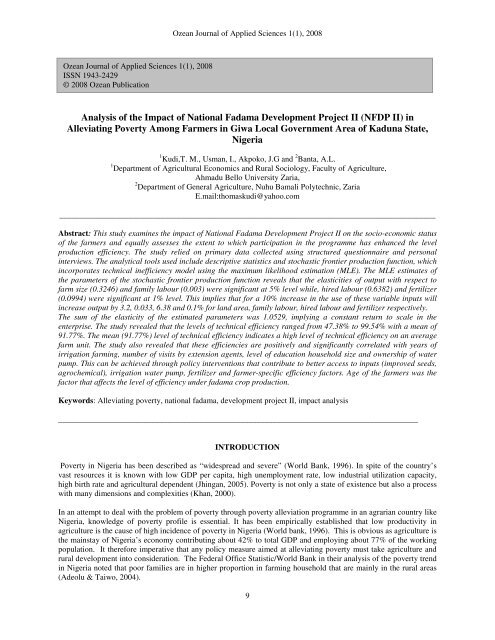Journal of Applied Science Studies - Ozean Publications
Journal of Applied Science Studies - Ozean Publications
Journal of Applied Science Studies - Ozean Publications
Create successful ePaper yourself
Turn your PDF publications into a flip-book with our unique Google optimized e-Paper software.
<strong>Ozean</strong> <strong>Journal</strong> <strong>of</strong> <strong>Applied</strong> <strong>Science</strong>s 1(1), 2008<br />
<strong>Ozean</strong> <strong>Journal</strong> <strong>of</strong> <strong>Applied</strong> <strong>Science</strong>s 1(1), 2008<br />
ISSN 1943-2429<br />
© 2008 <strong>Ozean</strong> Publication<br />
Analysis <strong>of</strong> the Impact <strong>of</strong> National Fadama Development Project II (NFDP II) in<br />
Alleviating Poverty Among Farmers in Giwa Local Government Area <strong>of</strong> Kaduna State,<br />
Nigeria<br />
1 Kudi,T. M., Usman, I., Akpoko, J.G and 2 Banta, A.L.<br />
1 Department <strong>of</strong> Agricultural Economics and Rural Sociology, Faculty <strong>of</strong> Agriculture,<br />
Ahmadu Bello University Zaria,<br />
2 Department <strong>of</strong> General Agriculture, Nuhu Bamali Polytechnic, Zaria<br />
E.mail:thomaskudi@yahoo.com<br />
_____________________________________________________________________________________________<br />
Abstract: This study examines the impact <strong>of</strong> National Fadama Development Project II on the socio-economic status<br />
<strong>of</strong> the farmers and equally assesses the extent to which participation in the programme has enhanced the level<br />
production efficiency. The study relied on primary data collected using structured questionnaire and personal<br />
interviews. The analytical tools used include descriptive statistics and stochastic frontier production function, which<br />
incorporates technical inefficiency model using the maximum likelihood estimation (MLE). The MLE estimates <strong>of</strong><br />
the parameters <strong>of</strong> the stochastic frontier production function reveals that the elasticities <strong>of</strong> output with respect to<br />
farm size (0.3246) and family labour (0.003) were significant at 5% level while, hired labour (0.6382) and fertilizer<br />
(0.0994) were significant at 1% level. This implies that for a 10% increase in the use <strong>of</strong> these variable inputs will<br />
increase output by 3.2, 0.033, 6.38 and 0.1% for land area, family labour, hired labour and fertilizer respectively.<br />
The sum <strong>of</strong> the elasticity <strong>of</strong> the estimated parameters was 1.0529, implying a constant return to scale in the<br />
enterprise. The study revealed that the levels <strong>of</strong> technical efficiency ranged from 47.38% to 99.54% with a mean <strong>of</strong><br />
91.77%. The mean (91.77%) level <strong>of</strong> technical efficiency indicates a high level <strong>of</strong> technical efficiency on an average<br />
farm unit. The study also revealed that these efficiencies are positively and significantly correlated with years <strong>of</strong><br />
irrigation farming, number <strong>of</strong> visits by extension agents, level <strong>of</strong> education household size and ownership <strong>of</strong> water<br />
pump. This can be achieved through policy interventions that contribute to better access to inputs (improved seeds,<br />
agrochemical), irrigation water pump, fertilizer and farmer-specific efficiency factors. Age <strong>of</strong> the farmers was the<br />
factor that affects the level <strong>of</strong> efficiency under fadama crop production.<br />
Keywords: Alleviating poverty, national fadama, development project II, impact analysis<br />
_________________________________________________________________________________________<br />
INTRODUCTION<br />
Poverty in Nigeria has been described as “widespread and severe” (World Bank, 1996). In spite <strong>of</strong> the country’s<br />
vast resources it is known with low GDP per capita, high unemployment rate, low industrial utilization capacity,<br />
high birth rate and agricultural dependent (Jhingan, 2005). Poverty is not only a state <strong>of</strong> existence but also a process<br />
with many dimensions and complexities (Khan, 2000).<br />
In an attempt to deal with the problem <strong>of</strong> poverty through poverty alleviation programme in an agrarian country like<br />
Nigeria, knowledge <strong>of</strong> poverty pr<strong>of</strong>ile is essential. It has been empirically established that low productivity in<br />
agriculture is the cause <strong>of</strong> high incidence <strong>of</strong> poverty in Nigeria (World bank, 1996). This is obvious as agriculture is<br />
the mainstay <strong>of</strong> Nigeria’s economy contributing about 42% to total GDP and employing about 77% <strong>of</strong> the working<br />
population. It therefore imperative that any policy measure aimed at alleviating poverty must take agriculture and<br />
rural development into consideration. The Federal Office Statistic/World Bank in their analysis <strong>of</strong> the poverty trend<br />
in Nigeria noted that poor families are in higher proportion in farming household that are mainly in the rural areas<br />
(Adeolu & Taiwo, 2004).<br />
9

















